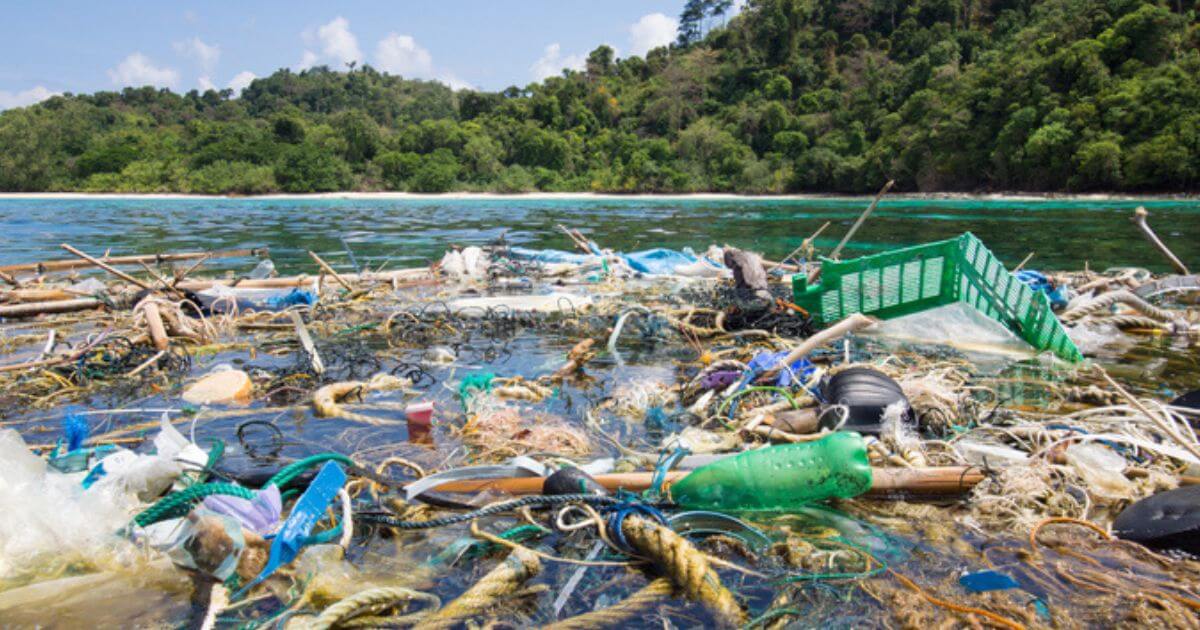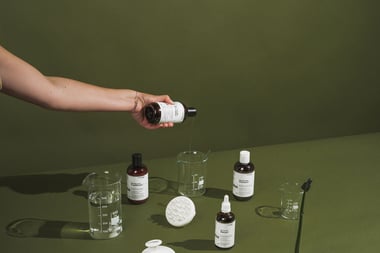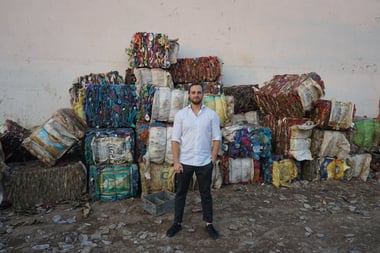
Beth Howell
Beth has been writing about the environment and climate change for over four years now – with her work being featured in publications such as The BBC, Forbes, The Express, Greenpeace, and in multiple academic journals.
There are now an estimated 170 trillion particles of plastic in the ocean, according to a recent study by 5 Gyres. That’s roughly 21,250 pieces of plastic for every person on the planet.
It’s not surprising then that plastic is the leading source of ocean pollution — but what are the other major ocean pollutants? We’ll answer that question, and many more, in this helpful guide.
Want to help stop ocean pollution? Us too.
We're running a beta program to see if there is interest out there for individuals, like you, to help us prevent plastic pollution, just like we do with our amazing partner brands.
Sign up here to wave your flag of support 👇
OK, back to the business of ocean pollutants. Let's get stuck in...
What’s on this page?
01 | What are the most common sources of ocean pollution?02 | Ways to reduce plastic pollution in the ocean
03 | Summary
04 | FAQs
What are the most common sources of ocean pollution?
|
Rank |
Source |
Key impacts |
|
1 |
Plastic pollution |
• Animals can ingest items • Chemicals from plastic seep into water • Litters ecosystems |
|
2 |
Nutrient pollution |
• Causes “dead zones” • Reduces oxygen levels in water |
|
3 |
Non-point source pollution |
• Difficult to locate the initial cause • Affects drinking water supplies • Harmful for fish and other wildlife |
|
4 |
Light pollution |
• Disrupts marine life behavioral patterns • Impacts fertility rates in some animals • Exposes vulnerable creatures to prey |
|
5 |
Noise pollution |
• Drowns out communication between animals • Can lead to internal hemorrhaging in some animals • Can cause permanent deafness |
|
6 |
Industrial pollution |
• Causes “dead zones” • Impacts the quality of drinking water • Can poison animals, putting them in danger |
1. Plastic pollution
Our planet has a plastic problem. This harmful material has made its way into every corner of the planet, with the ocean being its biggest victim. In fact, at least 14 million tons of plastic end up in the ocean every year, making up 80% of all marine debris, according to the International Union for Conservation of Nature. This isn't sustainable for our environment.
What’s more, a large portion of this plastic becomes unrecyclable over time because of the degradation from ocean salt and the sun’s radiation, making it discolored, brittle, and fragmented.
Researchers at the University of Cádiz also found that just 10 plastic products make up 75% of all polluting items in the ocean. According to the researchers behind the study, the top ocean pollutants are plastic bags, plastic bottles, food containers and cutlery, wrappers, synthetic rope, and fishing items.
Let’s look a bit closer at these key culprits.
Plastic bags
Plastic bags are one of the most deadly types of plastic in the ocean for marine life. With a likeness to translucent jellyfish, many animals mistake this item for food — and once digested, the plastic bag can cause serious harm.
The worst part? Plastic bags can take up to 20 years to decompose, which means they’re not going anywhere any time soon.
Their light weight also means they’re able to travel far and wide. In fact, a recent study revealed that a plastic bag is now the deepest known piece of plastic trash, after being found at a depth of 10,975 meters (36,000 feet) inside the Mariana Trench.
Plastic bottles
It’s estimated that plastic bottles take around 450 years to decompose. This, paired with the increased consumption of plastic bottles, means they’re one of the most commonly found bits of debris floating around the ocean.
Not only are these items choke hazards for animals, but chemicals also leech from the plastic into the water over time, further harming wildlife.
Although the reusable water bottle market is expected to grow by 3.9% a year, the plastic bottle crisis will never be solved until we implement safe drinking water systems in each country.
Food containers and cutlery
Like many items on this list, cutlery items and food containers are typically used for mere minutes before they’re thrown in the trash. At this point, we have to ask ourselves: is this convenience worth it?
We’d say no, considering some studies suggest disposable forks, spoons, and bowls can take up to 1,000 years to decompose naturally.
This is the prime reason why some nations around the world — including the UK, France, Italy, and India — have recently introduced plastic cutlery bans.
Wrappers
Large marine life often mistakes plastic wrappers and packets for prey, which can either choke the animal or put stress on certain organs when digested.
While some countries have the facilities to recycle wrappers and packets, most don’t. Even in the UK and the US, residents need to go to specific facilities to recycle wrappers and packets — a chore many aren’t willing to do.
Instead, people are left with the option of either sending these items to landfill, discarding them in public spaces, or burning them. And none of these options are good for the planet.
Synthetic rope
Although rope might not be an item you’d expect to see on this list, it accounted for almost 8% of the plastics found in the ocean, according to the University of Cádiz’s study.
So where does this rope come from? The most likely source would be the maritime industry, which includes the construction, repair, and scrapping of vessels, and the transportation of cargo and other materials across the ocean.
The University of Plymouth also found that these ropes could be responsible for releasing huge amounts of microplastics into the ocean — up to 760 fragments per meter.
2. Nutrient pollution
Nutrient pollution happens when excess nutrients, usually nitrogen and phosphorus, enter bodies of water and act as fertilizers.
These nutrients cause high levels of algae growth, which restrict sunlight and oxygen from entering the water — the two key ingredients needed to nurture aquatic plants. Without oxygen and sunlight, plants decay, which further lowers the oxygen levels in the water, and creates “dead zones” for marine life.
These excess nutrients usually come from agricultural runoff or wastewater generated from lawns, both of which generally contain fertilizer.
There are currently 415 dead zones around the world. The largest one is located in the Arabian Sea, covering the entire Gulf of Oman, with an area of 165,000 square kilometers (63,700 square miles).
Thankfully, dead zones are reversible if their causes are reduced or eliminated.
A quick fix would be planting trees and shrubs near water bodies, which would absorb nutrients before they reach the water. As for the long-term solution? We need to find alternatives to fertilizers in agriculture and horticulture.
3. Nonpoint-source pollution
Nonpoint-source pollution is waste that’s offloaded into waterways from multiple places at once. This makes it much harder to identify and address than point-source pollution, which only comes from one key source.
Although a lot of people are unfamiliar with this term, a recent study found that roughly 60% of water pollution in the US originates from nonpoint-source pollution.
Some of the causes of nonpoint-source pollution include:
- Excess fertilizers, herbicides, and insecticides from agricultural land
- Oil, grease, and toxic chemicals from urban runoff and energy production sites
- Bacteria and nutrients from livestock, pet waste, and faulty septic systems
- Sediment from poorly managed construction sites, crop and forest lands, and eroding stream banks
- Salt from irrigation practices, and acid drainage from abandoned mines
According to the United States Environmental Protection Agency (EPA), these pollutants have harmful effects on drinking water supplies, fisheries, and wildlife.
4. Light pollution
When we think about different types of ocean pollutants, light pollution is often overlooked.
Although it seems pretty harmless compared to plastic or chemicals, artificial light from urban areas has detrimental effects on marine life habitats, especially ones located in coastal areas.
To analyze how much of the ocean is impacted by light pollution, the Plymouth Marine Laboratory recently published an atlas of artificial light, under the sea at night. The researchers found that light pollution affects 1.9 million square kilometers of the world’s coastal seas, at a depth of one meter.
So how does light pollution impact ocean health?
The main concern for experts in the industry is that exposure to artificial light disrupts physiological behaviors in marine wildlife, especially those located in coastal regions.
By masking the natural cycle of the moon, light pollution impacts aquatic animals’ migration, reproduction, and feeding patterns. One study even showed that clownfish eggs were unable to hatch at all when they were exposed to artificial light.

5. Noise pollution
The majority of marine mammals communicate through sound, helping them to migrate, hunt, and reproduce effectively — some ocean mammals even use sound waves to help them see.
However, persistent noise made by ships, sonar devices, and other industrial procedures is drowning out these communications. This is detrimental to the health of marine wildlife, especially as maritime activity increases.
Excessive noise pollution can:
- Either seriously injure or kill marine animals, by triggering hemorrhaging in various organs
- Cause temporary or permanent deafness, which makes it impossible for numerous marine animals to feed, avoid prey, or reproduce
- Instigate avoidance and aggressive behavior
- Mask biological sounds, resulting in the loss of calls from predators or potential mates
6. Industrial pollution
Industrial pollution is essentially any waste generated from industry, such as factory runoff or chemical contamination.
This type of pollution overlaps heavily with nutrient pollution but can include other types of waste, such as acids and alkaline, scrap metals, sludge, and coal ash, to name a few.
Just like humans can’t ingest harmful chemicals, animals suffer immensely when surrounded by these harsh elements. Some of the worst impacts of industrial pollution include:
- Dead zones – Nutrient-packed fertilizers and sewage are making some environments inhabitable
- Chemical contamination – Insecticides, such as DDT, climb up the food chain, cause diseases, and kill birds that consume marine animals. This process even put the bald eagle on the endangered species list of the United States Fish and Wildlife
- Poisoning animals and humans – PFAS (a group of nearly 15,000 synthetic chemicals) are used to make heat, oil, stain, grease, and water-resistant materials. Once they’re leaked into the ocean, they become part of marine mammal blood and eventually enter the human body
5 ways to reduce plastic pollution in the ocean
Plastic tops our list of ocean pollutants, but there are a number of things we all need to do to turn this around.
Moving forward, we can eradicate plastic pollution by:- Stopping plastic pollution at the source
- Carrying out beach cleanups
- Avoiding agricultural runoff entering the oceans
- Creating business incentives to eliminate plastic use
- Developing and improving waste management laws
- Investing in plastic pollution innovations
Want to learn more about this? Head to our guide The Top 6 Ways to Clean Up the Ocean for everything you need to know.
Summary
The top six ocean pollutants are plastic, nutrients from fertilizer runoff, nonpoint sources, light, noise, and industrial chemicals. Plastic tops the list, with the most common items found in the ocean including bags, bottles, food containers and cutlery, wrappers, synthetic rope, and fishing items.
But it doesn’t have to be this way. It’s high time we cut down on plastic and evaluate our lifestyles. Every small eco-friendly change counts!
Want to help stop ocean pollution? Us too.
FAQs
What is the main cause of ocean pollution?
Plastic is the main type of pollution in our oceans. The top six ocean pollutants are plastic, nutrients from fertilizer runoff, nonpoint sources, light, noise, and industrial chemicals.
How harmful is ocean pollution?
Ocean pollution is harmful to absolutely everything involved — it kills precious ecosystems, threatens wildlife, and has been proven to affect human health.
Many marine ecosystems are getting damaged by ocean pollution, which has a knock-on effect on wildlife populations. And since everything in this world is connected, this is then having an impact on the rest of the food chain.
And when it comes to plastic pollution, roughly 100,000 marine animals die each year from either ingesting plastic or becoming entangled in fishing gear.
How much plastic is in the ocean in 2023?
As of 2023, there are an estimated 170 trillion particles of plastic in the ocean, according to a recent study by 5 Gyres. That’s roughly 21,250 pieces of plastic for every person on the planet.

.webp)
.webp?width=380&name=Plastic-pollution-surface-of-water%20(1).webp)

.webp?width=380&name=Dumped%20waste%20(1).webp)
.webp?width=380&name=CleanHub-waste-worker%20(1).webp)
-1.jpeg?width=380&name=8a81c9a8-61ad-450f-a366-9c4b7a70237c_8G3bu04g%20(1)-1.jpeg)
.webp?width=380&name=Small-islands%20(1).webp)

%20(1).jpg?width=380&name=MRF%20opening%20photo%203%20(1)%20(1).jpg)

.webp?width=380&name=Tech-on-the-globe%20(1).webp)
